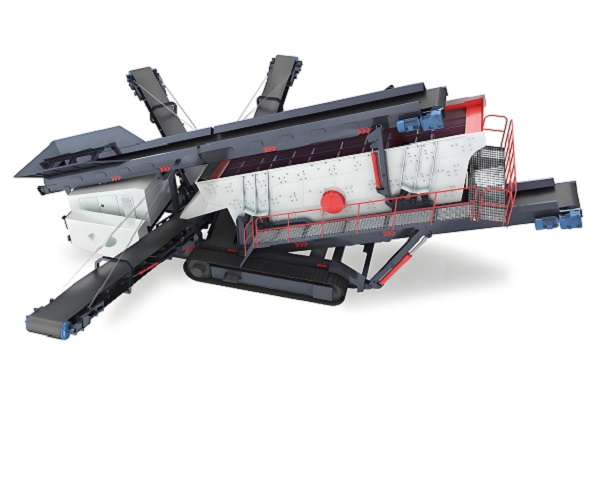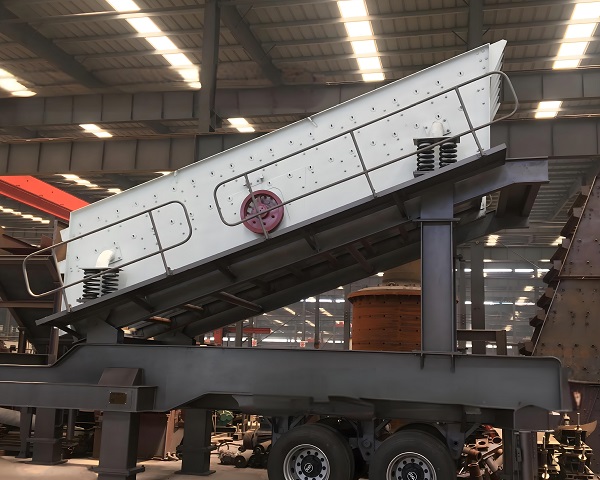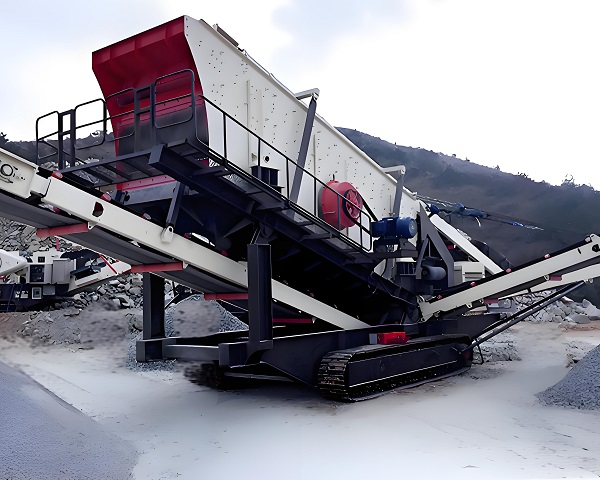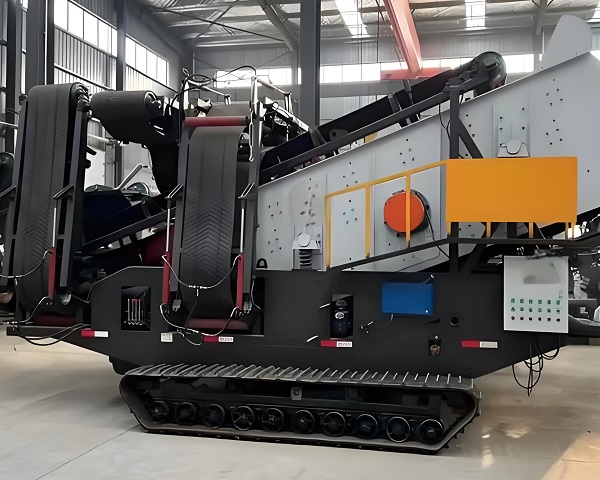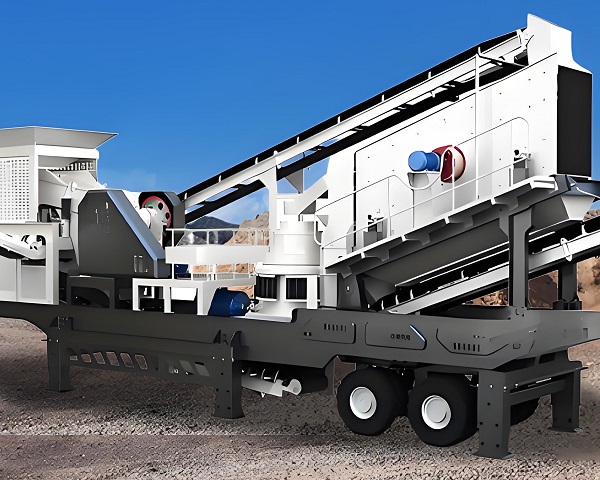A Trommel Screen is a rotary drum screening machine widely used in waste processing, mining, and construction industries. It efficiently separates materials by ......
What is the Mobile Vibrating Screen
Mobile vibrating screen is an efficient screening equipment that integrates vibrating screening and mobile functions. It is widely used in mining, sand and gravel aggregate, construction waste treatment and other industries. With its flexible and efficient characteristics, it brings a new solution for material screening operations.
In terms of structural composition, the mobile vibrating screen is mainly composed of a vibrating screen body, a feeding system, a conveying system, a mobile chassis and a control system. As the core component, the vibrating screen body generates an exciting force through a vibration motor, so that the screen surface vibrates with a specific frequency and amplitude to achieve material stratification and screening; the feeding system can evenly and stably feed the material into the screen surface; the conveying system is responsible for collecting and transporting materials of different particle sizes after screening; the mobile chassis is divided into tire type and crawler type according to demand. The tire type mobile vibrating screen is convenient for rapid transfer on flat roads, and the crawler type can travel unimpeded in complex terrains such as mountains and wetlands; the control system can accurately adjust the equipment operating parameters to ensure efficient and stable screening process.
The advantages of mobile vibrating screens are outstanding. It has strong mobility and does not require complicated installation and debugging. It can quickly arrive at the work site to carry out work, saving a lot of time and labor costs; the integrated structural design reduces the connection loss between equipment and improves the overall screening efficiency; in addition, the equipment can flexibly adjust the parameters such as the screen surface inclination and vibration frequency according to the material characteristics and screening requirements to meet the diverse screening needs and has strong adaptability.
In practical applications, mobile vibrating screens perform well. In the field of mining, it can accurately screen the crushed ore and provide qualified raw materials for the subsequent mineral processing process; in construction projects, it can grade sand and gravel aggregates to ensure the quality of engineering materials; in terms of resource utilization of construction waste, it can screen and classify mixed construction waste to help the production of recycled aggregates. With the development of industrial technology, mobile vibrating screens will continue to upgrade and play a greater role in more fields.
Operating principle of Mobile Vibrating Screen
Mobile vibrating screen is a mechanical equipment that combines mobility and efficient screening functions. It is widely used in mining, construction, chemical and other industries. Its working principle is based on mechanical vibration, and it realizes efficient separation and classification of materials through specific structural design.
From the perspective of structural composition, mobile vibrating screen is mainly composed of vibrating screen box, exciter, screen, mobile frame, drive device and other parts. Among them, the vibrating screen box is the core component, which is used to carry the screen and materials; the exciter is the key to generating vibration, and the common ones are eccentric block type and vibration motor type.
When the mobile vibrating screen is started, the drive device drives the exciter to operate. Taking the eccentric block exciter as an example, the eccentric block inside it rotates at high speed, generating a periodically changing centrifugal force. The centrifugal force causes the screen box to produce directional forced vibration, and the vibration direction is generally at a certain angle to the screen surface. The vibration of the screen box is transmitted to the screen, so that the screen also produces the same frequency vibration.
After the material enters the screen surface, it produces complex movements such as jumping and sliding under the action of vibration. Materials with a particle size smaller than the size of the sieve hole, under the action of vibration and its own gravity, fall through the sieve hole to the lower layer and become the under-sieve product; materials with a particle size larger than the size of the sieve hole continue to move forward on the screen surface and are finally discharged from the end of the screen surface to become the over-sieve product.
The mobile frame of the mobile vibrating screen, whether it is tire-type or crawler-type, gives the equipment the ability to flexibly transfer. In different work sites, the equipment can be moved quickly and put into work quickly without complicated installation and debugging. At the same time, by adjusting the eccentricity of the exciter, the vibration frequency and other parameters, the vibration intensity and amplitude of the screen box can be changed, and then the screening efficiency and quality of the material can be controlled to adapt to the screening operation of materials with different properties and different particle size requirements.
Advantages and features of Mobile Vibrating Screen
As an important equipment in the field of modern industrial screening, the mobile vibrating screen has brought efficient and convenient material screening solutions to the mining, metallurgy, building materials, environmental protection and other industries with its unique design concept and excellent performance. Its characteristics and advantages are remarkable.
Strong mobility is one of the most prominent features of the mobile vibrating screen. It is equipped with a tire-type or crawler-type mobile chassis, which can freely shuttle between different work sites, without complicated installation and debugging process, and can be put into use quickly. For example, in mining, it can be moved at any time according to the mining progress, which greatly improves the working efficiency. At the same time, the modular design enables the various components of the equipment to be flexibly combined and disassembled, which is convenient for transportation and transfer.
High screening efficiency is another major advantage. The equipment uses advanced vibration motors or exciters, which can produce efficient and stable vibration effects, prompting the materials to be quickly dispersed, layered and screened on the screen surface. By reasonably designing the screen angle, vibration frequency and amplitude, it can accurately screen materials of different particle sizes, humidity and properties, effectively improving the screening accuracy and processing capacity. Even in the face of wet and sticky materials, the specially designed vibration method can prevent the screen from being blocked, ensuring continuous and stable screening work.
Mobile vibrating screens have a high level of automation and intelligence. Equipped with an intelligent control system, it can monitor the operating status of the equipment in real time, automatically adjust key parameters such as vibration frequency and screen tension, and realize unmanned or less-manned operation. In addition, the equipment can also form a complete mobile screening production line with crushers, feeders, conveyors, etc., and work together through a unified control system, which greatly reduces labor costs and improves overall production efficiency. At the same time, the mobile vibrating screen has a compact structure and a small footprint, which reduces the cost of site occupation; the equipment operates stably and reliably, is easy to maintain, and effectively reduces the cost of use, creating greater economic benefits for the enterprise.
Technical Parameter Table of Mobile Vibrating Screen
| Specification / Model | Metso ST3.8 | Sandvik QA451 | Kleemann MS 953 EVO | Terex Finlay 883+ |
|---|---|---|---|---|
| Number of Decks | 2 or 3 decks | 3 decks | 3 decks | 2 or 3 decks |
| Screen Size | 5.5 × 1.5 m | 6.1 × 1.5 m | 6.1 × 1.95 m | 4.8 × 1.53 m |
| Screen Area | 8.25 m² / deck | 9.15 m² / deck | 11.9 m² / deck | 7.34 m² / deck |
| Capacity | 400 t/h | 600 t/h | 500 t/h | 450 t/h |
| Engine Power | 74 kW (CAT) | 96 kW (Volvo) | 100 kW (Stage V) | 82 kW (CAT) |
| Discharge Height | 3.6 m | 4.0 m | 3.9 m | 3.5 m |
| Control System | Touchscreen + Remote | PLC Intelligent | Remote + Touchscreen HMI | Remote |
| Total Weight | 32 tons | 40 tons | 38 tons | 34 tons |
If you have any special requirements, we will customize according to your special needs.
Product Picture Display of Mobile Vibrating Screen
FAQ about Mobile Vibrating Screen
>What is the working principle of the mobile vibrating screen?
The mobile vibrating screen relies on the exciting force generated by the vibration motor to drive the screen surface to vibrate periodically, so that the material jumps and rolls on the screen surface, and the material smaller than the size of the screen hole falls through the screen surface to achieve graded screening of materials of different particle sizes.
>What types of mobile vibrating screens are there?
They are mainly divided into two types: tire type and crawler type. The tire type mobile vibrating screen relies on road transportation, has flexible transfer, and is suitable for sites with good road conditions; the crawler type mobile vibrating screen has strong off-road capabilities and can operate freely in complex terrain such as mountains and wetlands.
>What are the core components of the mobile vibrating screen?
The core components include the vibrating screen body, vibrating motor, feeder, conveyor belt and mobile chassis. The vibrating screen body is responsible for screening, the vibrating motor provides power, the feeder ensures uniform material transportation, the conveyor belt completes material transportation, and the mobile chassis realizes equipment movement.
>What are the applicable materials for the mobile vibrating screen?
It is suitable for a variety of materials, such as ore in mining, sand and gravel aggregates required for construction, and solid waste such as construction waste and coal gangue, which can be graded.
>What are the advantages of mobile vibrating screens over fixed screens?
Mobile vibrating screens do not require complex infrastructure and can be quickly transferred to the work site, saving installation time and cost; the integrated design reduces intermediate links and improves production efficiency; it can flexibly adapt to different site operations, while the fixed screen has a fixed position and poor flexibility.
>How to adjust the screening efficiency of mobile vibrating screens?
The excitation force and vibration frequency can be changed by adjusting the eccentric block angle of the vibration motor, and the screen surface inclination can be adjusted to control the material's residence time and movement speed on the screen surface, while ensuring uniform and stable feeding, thereby improving screening efficiency.
>What are the key points of daily maintenance of mobile vibrating screens?
It is necessary to regularly check the wear of components such as vibration motors and conveyor belts, and clean up the blocked materials on the screen surface in time; ensure that the connecting bolts of each component are tightened; add lubricating oil to lubrication parts such as bearings according to regulations to ensure the normal operation of the equipment.
>What is the maximum output that a mobile vibrating screen can handle?
Its output is affected by factors such as equipment model, screen surface size, and material properties. Small equipment can produce tens of tons per hour, and large mobile vibrating screens can produce hundreds of tons or even higher per hour.
>How is the mobile vibrating screen used in construction waste treatment?
Mixed construction waste can be transported to the screen surface, and concrete blocks, bricks, metals, etc. can be separated by screening. The screened materials of different particle sizes can be processed into recycled aggregates for road base paving, unburned brick production, etc., to achieve resource recycling.
>Is the operation of the mobile vibrating screen difficult?
Modern mobile vibrating screens are equipped with intelligent control systems, and the operation interface is simple and easy to understand. After simple training, operators can master basic operations such as equipment start and stop, parameter adjustment, etc., and then safely and efficiently manage the equipment operation.
>What factors affect the service life of the mobile vibrating screen?
The service life of the equipment is closely related to the frequency of use, maintenance, material properties and operating specifications. Reasonable control of workload, regular maintenance, and standardized operation procedures can effectively extend the service life of the mobile vibrating screen.


























